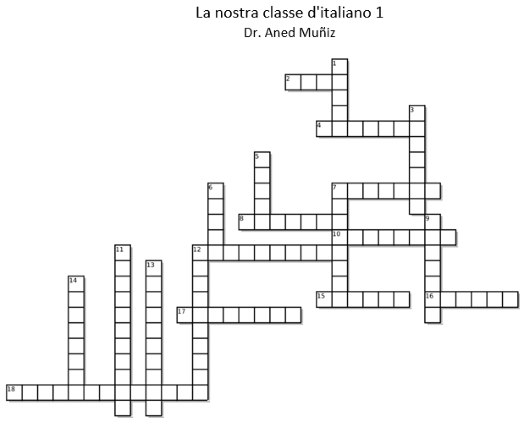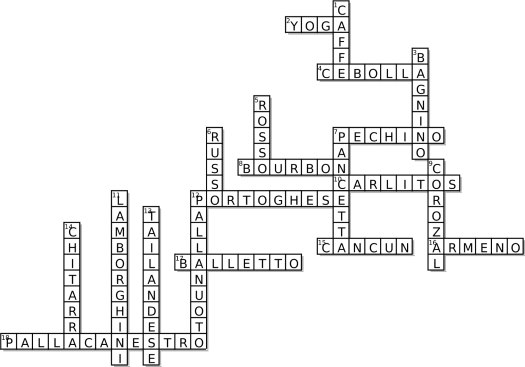A Personalized Conversation Puzzle
Aned Muñiz, California and Puerto Rico, United States of America
Dr. Aned Muñiz started teaching at the University of Hawaii (Honolulu) in 1996, and has lived and taught in California institutions of higher learning since 2001. She is also a writer, newspaper contributor, and founder of Centro de Idiomas del Caribe and the Caribbean Institute for Multilingualism and Multicultural Education. E-mail: aned@sandiego.edu
The following is an activity which I have successfully integrated to my college and university classes in California. It can be adapted to almost every level, including elementary or beginner courses, right after they study basic verb conjugations, by simplifying the language to meet the students’ skills.
I first used the crossword activity as a quick review before tests including vocabulary, and added words which had given students difficulty, plus those which tend to confuse students with their spelling. A crossword puzzle forces students to spell these words correctly (at least with the appropriate number of letters), or otherwise the activity cannot be successfully completed. Completing this kind of activity and reviewing the correct answers in the hour before a written test tremendously improved the students’ accuracy with all words which appeared both in the review and in the test.
I also began to experiment with students working together in groups as a sort of friendly competition, and around 2010 I began mixing student information within the puzzles, in order to increase student interaction. I gave no instructions except to complete the crossword, and was told “But, professor, I don’t know Rosaura’s favorite color”, to which I responded “Then why don’t you ask her?” and demonstrated the question, much to the delight of the entire class, which readily stood up and began interacting in the target language.
I found the activity more successful when students walked around the classroom asking each other questions. But more importantly, when students became the protagonists in the activity, their enthusiasm and pride was hard to conceal. They asked for extra copies of the crossword for safekeeping, took photos and posted them on Facebook, sent them to their parents, and kept glowing smiles throughout the activity. They clearly put more effort in asking questions correctly and getting to know the answers to their classmates’ clues. This, evidently, strengthened their sense of belonging and ownership in this class. As part of a student-centered approach in which each individual and his/her contributions are valued, this type of activity motivates participants, whose enthusiasm for learning and for the subject being taught increases. Having the ability to communicate in the target language and complete interesting or fun tasks, which are within their proficiency or skill level, and helped by their classmates, also lowers the affective filter and helps enhance an atmosphere conducive to learning.
Eventually I began to create a version of the crossword solely with student information, towards the end of each semester. And while the crossword itself cannot be recycled (a new one will have to be made for each class), the preparation time for each will be less than 45 minutes if you use an online crossword creation tool. I have used www.puzzle-maker.com/CW/ for the past 5 years, but an online search under “crossword puzzle maker” will yield more options. Keep in mind that if you use the 100% free version you will not be able to save a good copy on your computer. Most likely, you will need to print the puzzle on two or three separate pages and use old fashioned cut and paste (paper and scissors) to make it fit on one prior to copying. However, the resulting paper copies can be easily scanned and stored, should you wish to keep them for your records, or submit digitally to printing.
The enclosed sample crossword was prepared for a first semester Italian class, but it can be adapted for every level and other languages written with an alphabet. I have successfully prepared this activity for Italian, English, German, French, Russian (using a different crossword creation tool) and Spanish classes. Keep in mind, however, that not many crossword creation tools support accents or other special characters. Student names have been replaced by initials.

ORIZZONTALE
2. Attività con cui E.F. combatte lo stress.
4. Nomignolo del cane nero, "fratello" di Yuca.
7. Città dove abitano i genitori di S.Z.
8. 8. Il nome del cane di R.H.
10. Il nome della macchina di C.
12. Lingua madre di S.
15. Dove A. e B. vanno in vacanza.
16. Lingua che parla la famiglia di N.
17. Classe di A. V.dopo questa.
18. Sport che pratica C.G. ogni giorno.
|
VERTICALE
1. Bibita di origine etiope (o mediorientale) che piace molto agli studenti, specie alle sorelle.
3. Lavoro che fa F.P. nelle spiagge di Santa Monica.
5. Il colore preferito della professoressa.
6. Lingua madre di V.M.
7. Cibo preferito di J.
9. La professoressa è di ________, Puerto Rico.
11 M.L. sogna con avere una di queste famose macchine italiane.
12 Sport che praticano C. e P.
13 Tipo di cibo servito nel ristorante dove lavora L.
14 Strumento che suonano C., R. e R.
|
Translation
HORIZONTAL
2. Activity with which E.F. fights stress.
4. Yuca’s black canine ‘brother’.
7. City where S.Z.’s parents live.
8. R.H.’s dog
10. C.’s car
12. S.’s native language
15. Where A. and B. are going on vacation.
16. Language spoken by N.’s family.
17. A. V.’s class after this.
18. C.G. practices this sport every day.
|
VERTICAL
1. Drink of Ethiopian (or Middle Eastern) origin; quite beloved by most in this class, specially the sisters G.
3. F.P. works as one on Santa Monica’s beaches.
5. Your professor’s favorite color.
8. V.M.’s native language.
9. J. ‘s favorite food.
10. Our professor is from________, Puerto Rico.
15 M.L. dreams of owning one of these famous Italian sports vehicles.
16 C. and P. are in our college’s team of this sport.
17 Cuisine served at L.’s restaurant.
18 C., R. and R. all play this instrument.
|
RISPOSTE


Please check the Creative Methodology for the Classroom course at Pilgrims website.
Please check the Practical uses of Technology in the English Classroom course at Pilgrims website.
Please check the here at Pilgrims website.


|